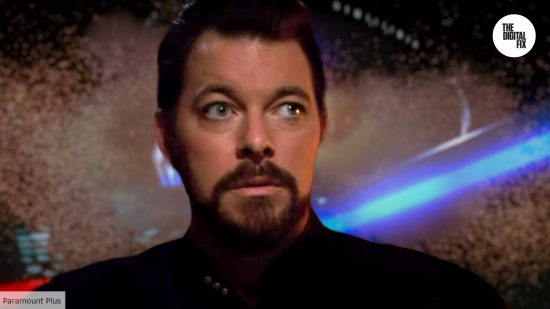One of Star Trek The Next Generation‘s greatest strengths was its ability to juggle various tones and genres. Tuning in to a new episode, you were just as likely to find a fun, action-centric adventure as you were a thoughtful meditation on McCarthyism, or even an outright comedy. Crucially, with a sublime roster of brilliantly cast characters and an episodic format, the show gave itself the foundation to go just about anywhere.
And go anywhere it did, including a brave time-loop episode that helped to give birth popularize the mind-twisting genre, a year before the release of Groundhog Day. In Star Trek TNG season 5, audiences were met with the episode ‘Cause and Effect’, directed by Jonathan Frakes. The episode centered around a single day repeating itself over and over due to a temporal distortion, and the subsequent attempts by the Star Trek characters to escape the phenomenon.
Like Groundhog Day, the conceit of the episode was that the same scenes would play over and over, always ending in the destruction of the USS Enterprise-D before being reset. This was so unexpected, and such a new concept for audiences, that ‘Cause and Effect’ writer Brannon Braga remembers how people viewing it for the first time actually phoned TV studios, believing there to be a mistake with the broadcast.
“This was back when people would call into TV stations, I guess,” Braga explained to SyFy. “The show was syndicated, as you know, and the affiliates were getting phone calls during the broadcast [saying] something was wrong with the broadcast.”

That might seem amusingly ignorant now, but back when the episode aired, audiences weren’t at all familiar with the time-loop trope. Again, this was pre-Groundhog Day. Instead, from their perspective, the episode was simply repeating itself again, and again.
Of course, audience members who were paying close attention wouldn’t have felt the need to ring into a TV studio to check that the broadcast was working, because as the episode progresses, each new version of the day is shot slightly differently by Frakes. It’s part of what makes the episode so good: the audience is figuring out what’s going on alongside the characters, piecing the clues together with them.
In fairness, though, it wasn’t just sections of the audience who were left confused when they were first presented with the episode. Speaking with Insider, Braga explained that the Star Trek TNG cast, including Frakes, thought it was a “practical joke” at first. Either that, or it was just a mistake.
Ultimately, pushing the envelope in this way was a huge risk for the Star Trek series, but Braga rationalized the decision by explaining they ultimately decided they had to accept the potential for failure. “If it fails, it fails. We had 26 episodes a season.”
It’s that philosophy, and capacity for experimentation, that helped TNG become one of the best TV series of all time. Its scope was almost infinite, with the episodic format allowing the writing teams to make massive gambles week to week. Once the show hit its stride from season 3 onwards, those gambles almost always paid off, too, resulting in unparalleled brilliance.
For more on Star Trek, check out our guide to the Star Trek timeline, or read our ranking of the Star Trek captains. You can also learn about progress on Strange New Worlds season 3, and read our interview with Anson Mount and Rebecca Romijn.
